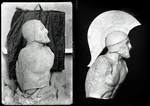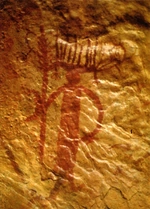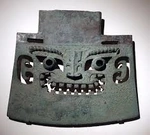The Biblical Measurements, Or Israelite Society Metrology, Cultural Background

To the attention of our honorable reader: The authors are staying far away from any religious point of view. We beg you, if you hold sentiments related to faith, to understand that our collective bears not even the slightest intention of harming your orthodox feelings.
We cannot skip over such culture as the David Dynasty Kingdom, based on its giant impact on later (by religious aspect) influence in shaping Western civilisation.
Most of our readers are well acquainted with the Gospel stories, telling us about the events related to the Judean Kingdom’s failure period.
And the source, actively cited in the narrations, is the Bible itself; both of these sources we cannot use as archaeological evidence — out of their sacrality and from respect for religious groups (we hope all of us respect human rights in this aspect as well) — and mainly because these sources are not acceptable from the point of view of archaeological standards.
But as the starting point of the trip to prehistoric Israel State and its culture-based structural construct, to which we definitely rely the measurements and their standardisation, no one has the power to interfere with us.
Before the World Was Born, or the Establishment of the Judah Kingdom
In this section, we briefly pass through the conditions and evidence that led to the Kingdom’s appearance.
Introduction to the period, first settlements, regional cultural mapping
In the beginning was the Word, and the Word was with God, and the Word was God. He was with God in the beginning. Through Him all things were made; without Him nothing was made that has been made. In Him was life, and that life was the light of all mankind.
In scientific terms, as we know, any civilisation is always human-centric. Logically, humanity stands as the modifying factor of everything around us that originates in nature—without even mentioning all that possesses an artificial nature as well.
Thus, to understand the origins of social structures, we must dig into the evidence from just before such structures begin to reveal themselves. This approach is applicable to the famous Kingdom of Judah’s pre-establishment period, which we will reconstruct here.
Before the establishment of the Kingdom of Judah, the region was inhabited by various Canaanite tribes. Archaeological findings indicate that these Canaanite communities practiced urbanization, agriculture, and trade. For instance, the site of Tel Dan, located in the northern part of ancient Israel, has yielded evidence of Canaanite occupation, including city gates and fortifications dating back to the Middle Bronze Age (c. 2000–1550 BCE). These developments laid the groundwork for the emergence of Israelite culture in the region.
By the Late Bronze Age (c. 1550–1200 BCE), the Canaanite city-states began to decline, possibly due to invasions and internal upheavals. This period saw the gradual infiltration and settlement of groups identified as Israelites. Archaeological evidence from sites such as Khirbet Qeiyafa and Khirbet al-Ra'i suggests that these early Israelite settlements were characterized by fortified structures and distinct pottery styles, indicating a move toward centralized organisation and state formation.
- As evidence of the early stage of this period, let us consider three main sites, carefully and thoroughly examined up to the present time.
🌇 Khirbet Qeiyafa
- Located in the Elah Valley, Khirbet Qeiyafa is one of the most significant archaeological sites associated with early Judah. Excavations have uncovered a fortified city with casemate walls, a city gate, and a large public building, all dating to the early 10th century BCE. The site's strategic location and architectural features suggest it served as a military outpost or administrative centre during the reign of King David.
🌇 Khirbet al-Ra'i
- Situated near Khirbet Qeiyafa, Khirbet al-Ra'i provides additional insights into early Judahite society. Artifacts from this site include pottery and inscriptions that align with the material culture of the period, supporting the notion of a developing Judahite identity distinct from neighboring cultures.
🌇 Lachish
- The site of Lachish, mentioned in biblical texts, has yielded evidence of fortifications and administrative structures dating to the late 10th century BCE. These findings corroborate the biblical account of King Rehoboam's fortification efforts and the expansion of Judah's territory during this period.
But to be crystal fair, we should note, that the Tel Dan Stele, an Aramaic inscription dating to the 9th century BCE, contains the phrase 'House of David' providing the earliest known extrabiblical reference to King David. Such inscriptions are crucial for understanding the historical context and confirming the existence of key figures mentioned in biblical narratives.
The Settlements And Structure Of Early Israelites
Early Israelite society was primarily agrarian and organized around extended family units. Archaeological evidence indicates that Israelites lived in nuclear households, often clustered in small villages. These homes were typically constructed with mudbrick and stone, featuring multiple rooms and sometimes a second story. The layout often included a courtyard for domestic animals, reflecting a subsistence economy based on agriculture and pastoralism. Villages were situated in the central hill country, an area less influenced by neighboring urban centres, which contributed to the development of a distinct Israelite identity.
During the period of the Biblical Judges, Israelite society lacked a centralized monarchy and was instead organized into tribes led by judges. These leaders were often charismatic figures who arose in times of crisis to deliver the Israelites from oppression. Over time, the desire for a centralized leadership led to the establishment of the monarchy, beginning with King Saul. The king's role was to unify the tribes, lead military campaigns, and establish a centralized administration.
Did they have a communal measurement system at this period? Indeed, they did. We will trace the origins of that system later; for now, let us continue describing the socio-cultural background. In the next section, devoted to their written tradition, we will begin to follow the object of our primary interest.
Speculations Of The Hebrew Language Origin, But Not Only Speculations...
First of all, let us glance at the evidence that brings context to the discussion:
- Khirbet Qeiyafa Ostracon (c. 10th century BCE): A pottery shard inscribed with five lines of text, possibly reflecting an early form of the Hebrew language. Its exact linguistic classification remains debated.
- Gezer Calendar (c. 10th century BCE): A limestone tablet listing agricultural activities, providing insights into the seasonal life of the Israelites.
- Tel Zayit Abecedary (c. 10th century BCE): A limestone boulder inscribed with a complete Phoenician alphabet, marking a significant stage in the development of alphabetic writing.
- Siloam Inscription (c. 8th century BCE): A Hebrew inscription found in the Siloam Tunnel in Jerusalem, commemorating the tunnel’s construction during King Hezekiah’s reign.
- Ketef Hinnom Scrolls (c. 7th century BCE): Silver amulets inscribed with portions of the Priestly Blessing, among the oldest known biblical texts.
The artefacts listed above show that the development of Hebrew writing evolved from the Phoenician script—a derivative of the Proto-Canaanite alphabet.
The origins of the Hebrews are complex and multifaceted, with several theories regarding their emergence:
- Indigenous Development: Some scholars propose that the Hebrews were native to the central hill country of Canaan, gradually forming a distinct identity through cultural and religious practices.
- Canaanite Continuity: Genetic studies indicate that modern Jewish and Arab populations of the region share significant ancestry with ancient Canaanites, suggesting continuity and assimilation over time.
- Exodus Tradition: The biblical account of the Exodus describes the Hebrews’ migration from Egypt to Canaan. While archaeological evidence for this event remains limited, it continues to hold central importance in Hebrew identity and history.
❗ Metrology and measurement systems have always advanced alongside writing systems. Here, it is important to emphasize that the Israelites employed a numerical structure based on the decimal system, similar to other ancient Near Eastern cultures. This system was used in various aspects of daily life, including trade, agriculture, and religious observance. Inscriptions from the period, such as those found at Tel Arad, indicate that the Israelites possessed a sophisticated understanding of time and numerical organisation, as evidenced by references to months and days in their records.
Here the author found appropriate place to list The Kings of ancient Israel State, and finalize the section with its measurement system...
The Kings of the Kingdom of Israel — The House of David (Formally)
A brief account of the Crown’s representatives presented as a chronological overview of the kings of the Kingdom of Judah, from its establishment in the 10th century BCE until the Babylonian conquest in 586 BCE. This timeline includes the duration of each king’s reign, their character as depicted in biblical narratives, and the notable events that occurred during their rule.
- 1.👑 Rehoboam (c. 931–913 BCE):
- - Reign: 17 years, Character: Generally considered a 'bad' king, Notable Events: His harsh policies led to the division of the united monarchy; the northern tribes rebelled, forming the Kingdom of Israel
- 2.👑 Abijah (Abijam) (c. 913–911 BCE):
- - Reign: 3 years, Character: Labeled as a 'bad' king, Notable Events: Engaged in a battle against Jeroboam of Israel; his reign was marked by continued conflict with the northern kingdom.
- 3.👑 Asa (c. 911–870 BCE)
- - Reign: 41 years, Character: Regarded as a 'good' king, Notable Events: Instituted religious reforms, removed idols, and sought alliances to strengthen Judah
- 4.👑 Jehoshaphat (c. 870–848 BCE):
- - Reign: 25 years, Character: Considered a 'good' king, Notable Events: Strengthened Judah's defenses, promoted religious education, and formed alliances with Israel
- 5.👑 Jehoram (c. 848–841 BCE):
- - Reign: 8 years, Character: Viewed as a 'bad' king, Notable Events: Married Athaliah, daughter of Ahab of Israel; his reign was marked by internal strife and external threats
- 6.👑 Ahaziah (c. 841 BCE):
- - Reign: 1 year, Character: Considered a 'bad' king, Notable Events: Aligned with Israel's King Jehoram; killed by Jehu during Jehu's coup in Israel
- 7.👑 Athaliah (Queen) (c. 841–835 BCE):
- - Reign: 6 years, Character: Often labeled as a 'bad' ruler, Notable Events: Usurped the throne after the death of her son Ahaziah; her reign ended when she was overthrown by Jehoiada the priest
- 8.👑 Joash (Jehoash) (c. 835–796 BCE):
- - Reign: 40 years, Character: Initially a 'good' king, Notable Events: Restored the Temple; later turned to idolatry, leading to his assassination by his officials
- 9.👑 Amaziah (c. 796–767 BCE):
- - Reign: 29 years, Character: Mixed; 'good' early, but later actions led to his downfall, Notable Events: Defeated Edom; later turned to idolatry, leading to his assassination
- 10.👑 Uzziah (Azariah) (c. 792–740 BCE):
- - Reign: 52 years, Character: Generally regarded as a 'good' king, Notable Events: Expanded Judah's territory; his later years were marked by pride and punishment
- 11.👑 Jotham (c. 750–735 BCE):
- - Reign: 16 years, Character: Considered a 'good' king, Notable Events: Strengthened Judah's defenses; his reign was overshadowed by his father's (Uzziah's) earlier actions
- 12.👑 Ahaz (c. 735–715 BCE):
- - Reign: 20 years, Character: Labeled as a 'bad' king, Notable Events: Introduced idolatry; sought Assyrian assistance, leading to Judah becoming a vassal state
- 13.👑 Hezekiah (c. 715–686 BCE):
- - Reign: 29 years, Character: Regarded as a 'good' king, Notable Events: Instituted religious reforms; successfully resisted Assyrian siege of Jerusalem
- 14.👑 Manasseh (c. 687–642 BCE):
- - Reign: 55 years, Character: Initially a 'bad' king; later repented, Notable Events: Reversed his father's reforms; later sought repentance and attempted reforms
- 15.👑 Amon (c. 642–640 BCE):
- - Reign: 2 years, Character: Considered a 'bad' king, Notable Events: Continued idolatry; assassinated by his own servants
- 16.👑 Josiah (c. 640–609 BCE):
- - Reign: 31 years, Character: Regarded as a 'good' king, Notable Events: Instituted major religious reforms; killed in battle against Pharaoh Necho II
- 17.👑 Jehoahaz (Shallum) (c. 609 BCE):
- - Reign: 3 months, , Character: Labeled as a 'bad' king, Notable Events: Deposed by Pharaoh Necho II; taken to Egypt
- 18.👑 Jehoiakim (c. 609–598 BCE):
- - Reign: 11 years, Character: Considered a 'bad' king, Notable Events: Initially a vassal of Egypt; later submitted to Babylon; faced internal unrest
- 19.👑 Jehoiachin (Jeconiah) (c. 598–597 BCE):
- - Reign: 3 months, Character: Viewed as a 'bad' king, Notable Events: Deported to Babylon during Nebuchadnezzar's siege
- 20.👑 Zedekiah (c. 597–586 BCE):
- - Reign: 11 years, Character: Considered a 'bad' king, Notable Events: Rebelled against Babylon; Jerusalem was besieged and destroyed; he was captured and taken to Babylon
- And here we may finalize the story of the Israelite Crown, but…
The Restoration of the Reign over the Kingdom of Israel
Post-Zedekiah: Babylonian Exile & Persian Period
- 586–538 BCE: Judah ceased to exist as a kingdom. The region became a Babylonian province, and much of the elite population was exiled (Babylonian Captivity).
- 538 BCE: King Cyrus the Great of Persia conquered Babylon and allowed the exiles to return. This is the start of the Second Temple period.
- No native monarchy: Upon return, Judah did not reestablish a Davidic king. Instead, governance was handled by: Persian-appointed governors (e.g., Zerubbabel as governor). High priests (religious and partial civil authority). Native elites: The returned Judahites (Zerubbabel, Joshua the High Priest, and others) formed the ruling local elite under Persian oversight. This system continued under Hellenistic rule and later under Roman client administration.
Later history flow gradualy showing us the decaying of social structures, and as a result, unevoidble falure of the state as is:
Roman Period (63 BCE onwards)
- Client kings: Rome reintroduced local kings, but these were Roman-appointed representatives, not fully sovereign rulers: Hasmonean dynasty became a client kingdom initially.
- Herod the Great (37–4 BCE) ruled as a Roman-appointed king. Herod’s successors ruled divided client territories.
- No restoration of full Davidic sovereignty: The monarchy under Rome was essentially symbolic and administrative, with real power held by Rome.
The Measurement Units and Their Historical Value
📏 Length and Distance Units
- Cubit (Amah):
Archaeological Evidence: The Siloam Inscription, dated to the 8th century BCE, mentions a length of 1,200 cubits for Hezekiah's tunnel. The tunnel's actual length is approximately 547 meters, suggesting a cubit length of about 45.75 cm.
- Handbreadth (Tefach) and Finger (Etzba):
Archaeological Evidence: While direct archaeological evidence for these units is limited, their use is inferred from biblical texts. For instance, the dimensions of the Tabernacle and its furnishings in Exodus are described using these units.
⚖️ Weight Units
- Shekel:
Archaeological Evidence: A stone weight inscribed with the word 'beka' was discovered near the Western Wall in Jerusalem. This weight is associated with the biblical half-shekel tax.
- Mina:
Archaeological Evidence: The weight system in ancient Judah was influenced by the Babylonian system, where the mina was a standard unit. Archaeological finds, such as weights and inscriptions, indicate the use of the mina in trade and temple offerings.
- Talent:
Archaeological Evidence: The talent, a large unit of weight, is mentioned in the construction of the Tabernacle in Exodus 38:24. Archaeological findings, including inscriptions and weights, confirm its use in large-scale transactions and offerings.
🧊 Volume Units:
- Ephah and Bath:
Archaeological Evidence: Inscriptions from sites like Tell Qasileh and other Judahite locations have been found with markings indicating the ephah and bath. These units were used for measuring grain and liquids, respectively.
- Seah, Hin, Omer:
Archaeological Evidence: These smaller volume units are mentioned in biblical texts and are inferred to have been used in daily life for measuring grain and liquids. Direct archaeological evidence is limited but supported by textual references.
| Unit | Archaeological Evidence | Estimated Length | Modern Equivalent |
|---|---|---|---|
| Cubit (Amah) | Siloam Tunnel inscription (~8th c. BCE), Judahite building remains | ~0.457 m | 1 cubit ≈ 0.457 m |
| Handbreadth (Tefach) | Inferred from cubit (Tabernacle dimensions) | ~0.114 m | 1 handbreadth ≈ 0.114 m |
| Finger (Etzba) | Inferred from handbreadth | ~0.019 m | 1 finger ≈ 1/6 handbreadth ≈ 0.019 m |
| Mile (Mil) | Persian-influenced units, used in late Judahite period | ~1,609 m | 1 biblical mile ≈ 1.609 km |
| Unit | Archaeological Evidence | Estimated Weight | Modern Equivalent |
|---|---|---|---|
| Gerah | Stone weight found in Jerusalem | ~0.57 g | 1 gerah ≈ 0.57 g |
| Shekel | Temple tax weights, First Temple period | ~11.4 g | 1 shekel ≈ 11.4 g |
| Bekah | Half-shekel stone weight | ~5.7 g | 1 bekah ≈ 5.7 g |
| Mina (Maneh) | Babylonian-influenced weights, inscriptions | ~574 g | 1 mina ≈ 574 g |
| Talent (Kikkar) | Large temple/treasury weights | ~34.4 kg | 1 talent ≈ 34.4 kg |
| Unit | Archaeological Evidence | Estimated Volume | Modern Equivalent |
|---|---|---|---|
| Log | Temple jars, ritual measurements | ~0.3 L | 1 log ≈ 0.3 L |
| Hin | Inscriptions at Judahite sites | ~3.7 L | 1 hin ≈ 3.7 L |
| Bath | Temple vessels (Solomon’s Temple) | ~22 L | 1 bath ≈ 22 L |
| Seah | Inferred from ephah | ~7.3 L | 1 seah ≈ 7.3 L |
| Ephah | Storage jars, grain measurements | ~22 L | 1 ephah ≈ 22 L |
| Omer | Manna portion, pottery inscriptions | ~2.3 L | 1 omer ≈ 2.3 L |
Sources are based on archaeological findings: Siloam Tunnel measurements, First Temple–period weights, storage jars, and inscriptions from Jerusalem, Lachish, Tel Arad, and related Judahite sites. These measurements represent averages, as exact standards varied slightly over time. Area units are inferred from agrarian practices (e.g., the ephah of grain sown per plot).
As you may notice, we have passed through the culture and reached the topic we were concerned about. Yet our journey through the cultures and their measurement systems has not even crossed the equator of the narration. So, for now, let us take a coffee break — and then we will meet you again at the Assyrian Kingdom, where we will explain why that culture was chosen by the authors.
This article is part of a long-read publication. [Go to the full version →]







This chapter devoted to two cultures, Babylonia and Persia, and here uncover why...

And here the place we should turning backward, to culture, already passed but under other angle...






